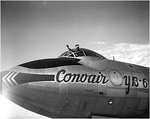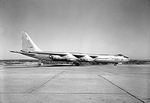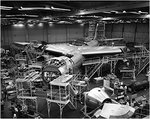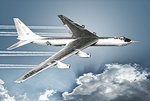Navigation
Install the app
How to install the app on iOS
Follow along with the video below to see how to install our site as a web app on your home screen.
Note: This feature may not be available in some browsers.
More options
You are using an out of date browser. It may not display this or other websites correctly.
You should upgrade or use an alternative browser.
You should upgrade or use an alternative browser.
Why did the Convair YB-60 fail?
- Thread starter Lucky13
- Start date
Ad: This forum contains affiliate links to products on Amazon and eBay. More information in Terms and rules
More options
Who Replied?Look at how thick the wing is at the root as opposed to the 52, that might be a good place to start.
T Bolt
Colonel
The B-52 was a jet from the start while the YB-60 was a piston engined aircraft converted to jet. There were a lot of attempts at that back then and none of them worked out.
Convair's YB-60 was well and truly rejected by the USAF...
"After flight test cancellation, Convair vainly attempted to convince the Air Force to continue interest in the YB-60. Convair even offered to complete the remaining B-36s on the production line as B-60s without charging the Air Force any more money. This proposal was turned down. Convair then tried to convince the Air Force that the YB-60 could be used as an experimental test bed for turboprop engines. This proposal was also rejected. Convair even considered trying to adapt the YB-60 as a commercial jet airliner. Nothing came of this idea either. There was even some consideration of using the YB-60 as a test vehicle for the proposed nuclear-powered X-6. This idea went nowhere as well" (Joe Baugher).
Looking at the timeline - the last B-36J was rolled outta the factory on the 14th August 1954. It's not saying much for the YB-60 that the USAF preferred to continue that piston B-36 production rather than accept "free" jet conversions proposed by Convair.
Some of the problems encountered...

"After flight test cancellation, Convair vainly attempted to convince the Air Force to continue interest in the YB-60. Convair even offered to complete the remaining B-36s on the production line as B-60s without charging the Air Force any more money. This proposal was turned down. Convair then tried to convince the Air Force that the YB-60 could be used as an experimental test bed for turboprop engines. This proposal was also rejected. Convair even considered trying to adapt the YB-60 as a commercial jet airliner. Nothing came of this idea either. There was even some consideration of using the YB-60 as a test vehicle for the proposed nuclear-powered X-6. This idea went nowhere as well" (Joe Baugher).
Looking at the timeline - the last B-36J was rolled outta the factory on the 14th August 1954. It's not saying much for the YB-60 that the USAF preferred to continue that piston B-36 production rather than accept "free" jet conversions proposed by Convair.
Some of the problems encountered...
And something else I ever noticed before. Well known photo below - but according to a recent article in Air Classics what the censor's scissors failed to cut from the original was the outline of a Hydrogen Bomb test shape seen at the bottom left in the background...

I have seen a construction photo that showed at least one of the prototypes with the 20 mm turrets installed.
drewwizard
Airman
- 41
- Dec 31, 2016
From what I read, it wasn't just the exterior design, but the electronics, flight controls, etc which were obsolete. The turbo prop version was a nice try. The russian TU-95 bear is still in use because of the efficiency of the turbo props. Just the noise they generate. Personally I thought the YB-60 was a much better looking aircraft. although I would have liked to see the flying wing with a extension on the front and a canard. That would have been highly efficient, and stable.
johnbr
2nd Lieutenant
e YB-60's first flight was three days after that of the Boeing YB-52 Stratofortress. In testing, it was 100 miles per hour (161 kilometers) slower than the B-52 prototype, despite using the same engines. A second B-60 prototype was cancelled before completion, and after 66 flight hours the YB-60 test program was cancelled. Both airframes were scrapped in 1954, with the second prototype never having flown.
The Convair YB-60 was 171 feet (52.121 meters) long with a wingspan of 206 feet (62.789 meters) and overall height of 60 feet, 6 inches (18.440 meters). The wings were swept at a 37° angle. It had an empty weight of 153,016 pounds (69,407 kilograms) and gross weight of 300,000 pounds (136,078 kilograms).
The prototype jet bomber was powered by eight Pratt & Whitney Turbo Wasp YJ57-P-3 turbojet engines. The J57 was a two-spool, axial-flow turbojet developed from an experimental turboprop engine. It had 16-stage compressor section (9 low- and 7-high-pressure stages), 8 combustors and a 3-stage turbine section (1 high- and 2 low-pressure stages). The YJ57-P-3s were rated at 8,700 pounds of thrust (38.70 kilonewtons), each. The YJ57-P-3 was 183.5 inches (4.661 meters) long, 41.0 inches (1.041 meters) in diameter and weighed 4,390 pounds (1,991 kilograms). These were the same engines used in the YB-52, and were similarly mounted in four 2-engine nacelles below the wings.
Maximum speed was 0.77 Mach (508 miles per hour, 818 kilometers per hour) at 39,250 feet (11,963 meters) and the combat ceiling was 44,650 feet (13,609 meters). The YB-60 could reach 30,000 feet (9,144 meters) in just over 28 minutes. Takeoff required 6,710 feet (2,045 meters) and 8,131 feet (2478 meters) were required to clear a 50-foot (15.24 meters) obstacle. Maximum range was 8,000 miles (12,875 kilometers) but the combat radius was 2,920 miles (4,699 kilometers) with a 10,000 pound (4,536 kilograms) bomb load.
The maximum bomb load was 72,000 pounds (32,659 kilograms). Defensive armament consisted of two M24A1 20 mm autocannon in a remote-controlled tail turret. The second YB-60 retained the upper forward and lower aft retractable gun turrets of the B-36, adding eight more 20 mm cannon.
The Convair YB-60 was 171 feet (52.121 meters) long with a wingspan of 206 feet (62.789 meters) and overall height of 60 feet, 6 inches (18.440 meters). The wings were swept at a 37° angle. It had an empty weight of 153,016 pounds (69,407 kilograms) and gross weight of 300,000 pounds (136,078 kilograms).
The prototype jet bomber was powered by eight Pratt & Whitney Turbo Wasp YJ57-P-3 turbojet engines. The J57 was a two-spool, axial-flow turbojet developed from an experimental turboprop engine. It had 16-stage compressor section (9 low- and 7-high-pressure stages), 8 combustors and a 3-stage turbine section (1 high- and 2 low-pressure stages). The YJ57-P-3s were rated at 8,700 pounds of thrust (38.70 kilonewtons), each. The YJ57-P-3 was 183.5 inches (4.661 meters) long, 41.0 inches (1.041 meters) in diameter and weighed 4,390 pounds (1,991 kilograms). These were the same engines used in the YB-52, and were similarly mounted in four 2-engine nacelles below the wings.
Maximum speed was 0.77 Mach (508 miles per hour, 818 kilometers per hour) at 39,250 feet (11,963 meters) and the combat ceiling was 44,650 feet (13,609 meters). The YB-60 could reach 30,000 feet (9,144 meters) in just over 28 minutes. Takeoff required 6,710 feet (2,045 meters) and 8,131 feet (2478 meters) were required to clear a 50-foot (15.24 meters) obstacle. Maximum range was 8,000 miles (12,875 kilometers) but the combat radius was 2,920 miles (4,699 kilometers) with a 10,000 pound (4,536 kilograms) bomb load.
The maximum bomb load was 72,000 pounds (32,659 kilograms). Defensive armament consisted of two M24A1 20 mm autocannon in a remote-controlled tail turret. The second YB-60 retained the upper forward and lower aft retractable gun turrets of the B-36, adding eight more 20 mm cannon.
Attachments
johnbr
2nd Lieutenant
vikingBerserker
Lieutenant General
I think the only real advantage the YB-60 had was the commonality of a lot of the parts with the B-36. I do agree it was a better looking aircraft IMHO.
johnbr
2nd Lieutenant
The B-52 was a jet from the start while the YB-60 was a piston engined aircraft converted to jet. There were a lot of attempts at that back then and none of them worked out.
SAAB J-21 as an exception?
johnbr
2nd Lieutenant
Users who are viewing this thread
Total: 1 (members: 0, guests: 1)




